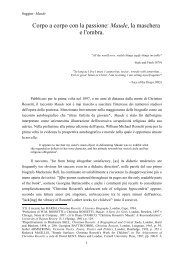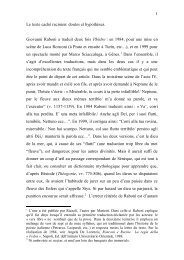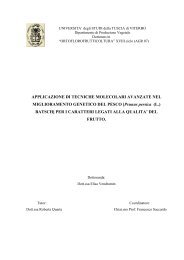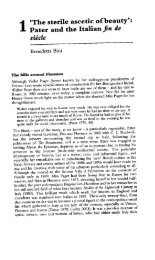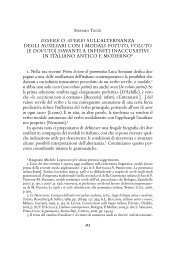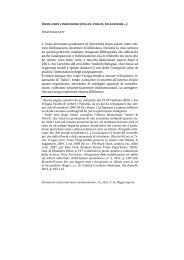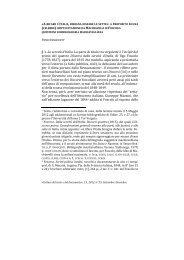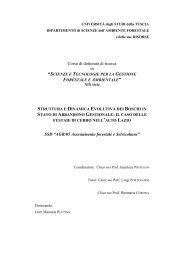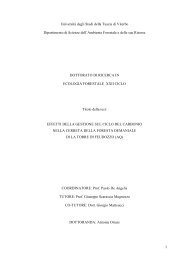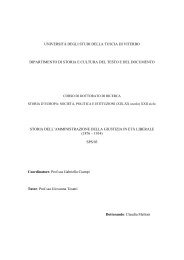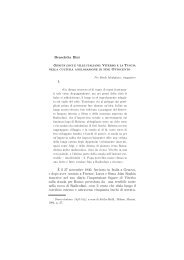drivers of soil respiration of root and microbial ... - Unitus DSpace
drivers of soil respiration of root and microbial ... - Unitus DSpace
drivers of soil respiration of root and microbial ... - Unitus DSpace
You also want an ePaper? Increase the reach of your titles
YUMPU automatically turns print PDFs into web optimized ePapers that Google loves.
Our experiment was conducted in a mediterranean grassl<strong>and</strong> (Amplero, Italy), aiming to cover<br />
the gap in the underst<strong>and</strong>ing <strong>of</strong> allocation patterns <strong>and</strong> speed <strong>of</strong> cycling <strong>of</strong> recently assimilated C in<br />
such type <strong>of</strong> ecosystems. Summarizing the above findings <strong>and</strong> uncertainties, the aims <strong>of</strong> the study<br />
were:<br />
• To monitor the dynamic <strong>of</strong> the 13 CO2 evolution from the <strong>soil</strong>, with <strong>and</strong> without shoots,<br />
aiming to get the peak <strong>of</strong> <strong>respiration</strong> <strong>of</strong> recently assimilated 13 C <strong>of</strong> <strong>root</strong>- <strong>and</strong> shoot-origin in<br />
situ under the real plant growing conditions.<br />
• To study temporal variation <strong>of</strong> source (photosynthetically active leaves)-sink (developing<br />
shoots, <strong>root</strong>s, leaves) interaction within the plant community: the fraction <strong>of</strong> new assimilated<br />
C respired below- vs. aboveground.<br />
• To compare the observed time lags obtained by non destructive technique <strong>of</strong> isotope pulse<br />
labeling with the results <strong>of</strong> widely diffused destructive technique, where the value <strong>of</strong> <strong>root</strong>-<br />
derived <strong>respiration</strong> is obtained by <strong>root</strong>-exclusion technique <strong>and</strong> is plotted vs. GPP from<br />
eddy covariance (performing both experiments in the same time).<br />
3.2. Materials <strong>and</strong> Methods<br />
3.2.1.Site description<br />
Amplero was established as a main CarboEurope site in central Italy near the city Collelongo<br />
(AQ) in the year 2002. A Mediterranean grassl<strong>and</strong> site, located at 900 m a.s.l. Amplero is a nearly<br />
flat to gently south sloping (2-3%) doline bottom with an average annual temperature <strong>of</strong> 10°C <strong>and</strong><br />
average annual precipitation <strong>of</strong> 1365 mm. The site is subjected to a long-term management since<br />
1950, which consists in a once-a-year mowing during the peak <strong>of</strong> the growing season <strong>and</strong> the rest <strong>of</strong><br />
the growing season the site is used as a pasture for cattle grazing.<br />
The <strong>soil</strong> is classified as Haplic Phaeozem (FAO classification) <strong>and</strong> contains 13% <strong>of</strong> s<strong>and</strong>, 33%<br />
<strong>of</strong> silt <strong>and</strong> 56% <strong>of</strong> clay, pHH2O <strong>of</strong> 6.6, total carbon (C) 3.48 % <strong>and</strong> total nitrogen (N) 0.28%. The<br />
plant cover is mainly represented by the following families: Caryophyllaceae (19%), Faseolaceae<br />
(30%) <strong>and</strong> Poaceae (34%).<br />
69




